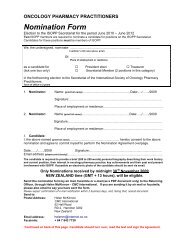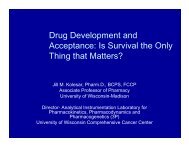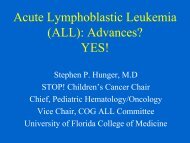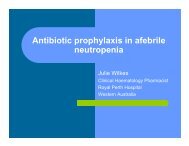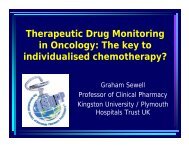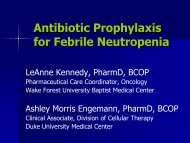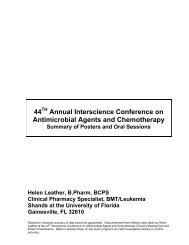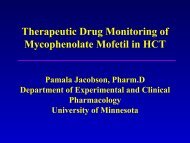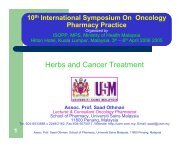Gastrointestinal Mucositis: It's not all about the mouth!
Gastrointestinal Mucositis: It's not all about the mouth!
Gastrointestinal Mucositis: It's not all about the mouth!
Create successful ePaper yourself
Turn your PDF publications into a flip-book with our unique Google optimized e-Paper software.
<strong>Gastrointestinal</strong> <strong>Mucositis</strong>:<br />
It’s s <strong>not</strong> <strong>all</strong> <strong>about</strong> <strong>the</strong> <strong>mouth</strong>!<br />
Dorothy Keefe<br />
RAH Cancer Centre &<br />
University of Adelaide
Clinical & Economic Outcomes of GI <strong>Mucositis</strong><br />
Pain<br />
Diarrhea<br />
Ulceration<br />
Distension<br />
Nausea<br />
Malabsorption<br />
Colonization<br />
Dysphagia<br />
Reduced<br />
Oral Intake<br />
Weight Loss/<br />
Malnutrition<br />
Electrolyte<br />
Imbalance<br />
Local<br />
Infection<br />
Fatigue<br />
Systemic<br />
Infection<br />
Bleeding<br />
DEATH<br />
2
Clinical & Economic Outcomes of GI <strong>Mucositis</strong><br />
Pain<br />
$$$<br />
Diarrhea<br />
$$$<br />
Ulceration<br />
$$$<br />
Distension<br />
Dysphagia<br />
Nausea<br />
Reduced<br />
Oral Intake<br />
$$$<br />
$$$<br />
Weight Loss/<br />
Malnutrition<br />
Fatigue<br />
$$$<br />
Electrolyte<br />
Imbalance<br />
DEATH<br />
Malabsorption<br />
$$$<br />
Systemic<br />
Infection<br />
Colonization<br />
Local<br />
Infection<br />
$$$<br />
$$$<br />
Bleeding<br />
$$$<br />
3
© MASCC 2004<br />
4
© MASCC 2003<br />
5
Oral <strong>Mucositis</strong> is <strong>not</strong> Just an<br />
Epi<strong>the</strong>lial Process<br />
Epi<strong>the</strong>lium<br />
Fibroblasts<br />
Submucosa<br />
Extracellular<br />
Matrix<br />
Inflammatory<br />
Infiltrate<br />
Endo<strong>the</strong>lium<br />
Platelets<br />
© MASCC 2004<br />
6
Today’s Pathobiology Perspective:<br />
A Multiple Mechanism Model<br />
Initiation<br />
Upregulation<br />
& Message Gen<br />
Signaling &<br />
Amplification<br />
Ulceration<br />
Healing<br />
RADIATION<br />
ROS<br />
ROS<br />
Outcome:<br />
•• Generation of of ROS<br />
within ROS<br />
cells<br />
•• Direct damage to to cells,<br />
tissues, & blood vessels<br />
•• Initiation of of o<strong>the</strong>r<br />
biological events<br />
ROS<br />
ROS<br />
ROS<br />
CHEMOTHERAPY<br />
© MASCC 2004<br />
7
Today’s Pathobiology Perspective:<br />
A Multiple Mechanism Model<br />
Initiation<br />
Upregulation<br />
& Message Gen<br />
Signaling &<br />
Amplification<br />
Ulceration<br />
Healing<br />
RT<br />
ROS<br />
CT<br />
Epi<strong>the</strong>lium<br />
Macrophages<br />
Endo<strong>the</strong>lium<br />
Cell<br />
Membrane<br />
Connective<br />
Tissue<br />
NF-κB<br />
Fibronectin<br />
Breaks Up<br />
DNA Injury<br />
Gene<br />
Upregulation<br />
Outcome:<br />
• Simultaneous Expression biological<br />
of Adhesion<br />
events in in <strong>all</strong> tissues Molecules& at<br />
at<br />
<strong>all</strong> levels<br />
Sphingomyelinase<br />
Ceramide Synthase<br />
Activates<br />
Macrophages<br />
COX-2<br />
Ceramide<br />
Pathway<br />
Clonogenic Cell Death<br />
MMP<br />
IL-1β<br />
IL-6<br />
Angiogenesis<br />
Apoptosis<br />
TNF-α<br />
Tissue Injury<br />
© MASCC 2004<br />
8
Today’s Pathobiology Perspective:<br />
A Multiple Mechanism Model<br />
Initiation<br />
Upregulation<br />
& Message Gen<br />
Signaling &<br />
Amplification<br />
Ulceration<br />
Healing<br />
RT<br />
ROS<br />
CT<br />
Epi<strong>the</strong>lium<br />
Connective<br />
Tissue<br />
NF-κB<br />
Fibronectin<br />
Breaks Up<br />
DNA Injury<br />
Gene<br />
Upregulation<br />
Outcome:<br />
Macrophages<br />
•• Biological cross talk &<br />
Expression<br />
Endo<strong>the</strong>lium<br />
amplification<br />
of Adhesion<br />
Molecules<br />
•• Generalized alteration of of <strong>the</strong><br />
Cell<br />
mucosal environment<br />
Membrane<br />
Sphingomyelinase<br />
•• Appearances can be deceiving<br />
Ceramide Synthase<br />
Activates<br />
Macrophages<br />
COX-2<br />
Ceramide<br />
Pathway<br />
Clonogenic Cell Death<br />
MMP<br />
IL-1β<br />
IL-6<br />
Angiogenesis<br />
Apoptosis<br />
TNF-α<br />
Tissue Injury<br />
© MASCC 2004<br />
9
Today’s Pathobiology Perspective:<br />
A Multiple Mechanism Model<br />
Initiation<br />
Upregulation<br />
& Message Gen<br />
Signaling &<br />
Amplification<br />
Ulceration<br />
Healing<br />
IL-1β<br />
TNF-α<br />
Bacterial Colonization<br />
Outcome:<br />
•• Cytokine amplification<br />
Cell W<strong>all</strong> Products<br />
•• Inflammation<br />
•• Pain<br />
IL-6<br />
•• Risk of of bacteremia &/or sepsis<br />
Activates<br />
Macrophages<br />
IL-6<br />
IL-1β<br />
TNF-α<br />
© MASCC 2004<br />
10
Today’s Pathobiology Perspective:<br />
A Multiple Mechanism Model<br />
Initiation<br />
Upregulation<br />
& Message Gen<br />
Signaling &<br />
Amplification<br />
Ulceration<br />
Healing<br />
Outcome:<br />
• Extracellular<br />
• Intact epi<strong>the</strong>lium<br />
• Matrix Signal<br />
• Tissue “appears” normal<br />
•• Residual angiogenesis<br />
•• The tissue you start with is<br />
is<br />
NOT <strong>the</strong> tissue you end with<br />
© MASCC 2004<br />
11
Lessons Learned from Oral <strong>Mucositis</strong><br />
• Extend to <strong>the</strong> entire GI tract<br />
Mouth<br />
Esophagus<br />
Stomach<br />
Sm<strong>all</strong><br />
Intestine<br />
Colon<br />
Rectum<br />
Anus<br />
© MASCC 2004<br />
12
The Alimentary Canal<br />
• The GI tract is <strong>all</strong> one tube from <strong>mouth</strong> to<br />
anus—formed from primitive endoderm<br />
Mouth<br />
Esophagus<br />
Pharyngeal gut<br />
Stomach<br />
Midgut<br />
Sm<strong>all</strong><br />
Intestine<br />
Colon<br />
Rectum<br />
Anus<br />
Hindgut<br />
© MASCC 2004<br />
13
The Alimentary Canal<br />
• Toxicities resulting from chemo<strong>the</strong>rapy or<br />
radio<strong>the</strong>rapy don’t occur in isolation<br />
• There are common mechanisms &<br />
systemic effects<br />
• The GI system can provide a whole<br />
new paradigm for research & new<br />
intervention strategies<br />
Chemo<strong>the</strong>rapy<br />
Radiation<br />
Therapy<br />
© MASCC 2004<br />
14
Normal Bowel Function<br />
Balance between<br />
• oral intake<br />
• secretions into gastrointestinal tract<br />
• fluid re-absorption in <strong>the</strong> gastrointestinal tract<br />
• (metabolism)<br />
Varies between 3 times daily and once every 3 days<br />
Consistency also important<br />
Normal volume depends on diet<br />
15
Fluid Into and Out of <strong>the</strong> Adult Alimentary<br />
Tract in 24 hours (in ml)<br />
IN<br />
By <strong>mouth</strong> 2000<br />
Salivary glands 1500<br />
OUT<br />
Sm<strong>all</strong> bowel 1500<br />
TOTAL IN<br />
~ 9000ml<br />
Stomach 2500<br />
Liver 500<br />
Pancreas 1500<br />
Stools estimated<br />
150ml<br />
Duodenum<br />
Jejunum 5000<br />
Ileum 2000<br />
Colon 1300<br />
TOTAL Absorbed<br />
~ 8300ml<br />
16
How can chemo<strong>the</strong>rapy alter <strong>the</strong> balance?<br />
Diarrhea<br />
Constipation<br />
(Unlikely to have increased Intake) 1. Decreased oral intake<br />
(dehydration)<br />
1. Decreased surface area<br />
of sm<strong>all</strong> bowel and<br />
2. Decreased motility<br />
colon (secretory(<br />
secretory)<br />
(increases time for re-<br />
absorption to occur)<br />
2. Increased motility<br />
(osmotic + secretory)<br />
3. Autonomic neuropathy<br />
3. Decreased enzyme<br />
4. Increased re-absorption<br />
activity (osmotic)<br />
5. Blockage<br />
4. Increased infective<br />
6. Overtreated diarrhea<br />
agents (infectious)<br />
7. Anti-nauseants<br />
nauseants<br />
5. Increased mucous<br />
8. Analgesics<br />
secretions (exudative(<br />
exudative)<br />
6. Overtreated constipation<br />
9. Decreased exercise<br />
17
Which anti-cancer agents do what?<br />
Diarrhea<br />
5-Fluorouracil<br />
Methotrexate<br />
Iri<strong>not</strong>ecan<br />
Taxanes<br />
Monoclonal antibodies<br />
Hormonal agents<br />
And most agents that have been<br />
tested<br />
Constipation<br />
Vinca Alkaloids<br />
Thalidomide<br />
Hormonal agents<br />
Probably o<strong>the</strong>rs<br />
18
Classification of Diarrhea<br />
Type<br />
Mechanism<br />
Example<br />
Chemo<strong>the</strong>rapy<br />
Secretory<br />
↑ Secretion of Elecs<br />
↓ Absorption of Elecs<br />
Cholera<br />
Bile salt enteropathy<br />
Yes after day 2<br />
Exudative<br />
Impaired colonic absorption<br />
Outpouring of cells<br />
+ colloid<br />
Ulcerative Colitis<br />
Shigellosis<br />
Amoebiosis<br />
Yes: if infection.<br />
Also with<br />
Iri<strong>not</strong>ecan<br />
Reduced<br />
Absorption/<br />
Osmotic<br />
Non-absorbable<br />
intraluminal<br />
molecules<br />
Lactase deficiency<br />
Mg 2+ containing<br />
laxatives<br />
Yes: if transient<br />
Lactase deficiency<br />
Anatomic<br />
derangement<br />
↓ Absorption Surface<br />
Subtotal colectomy<br />
Gastrocolic fistula<br />
Yes: early with<br />
reduced sm<strong>all</strong><br />
bowel surface area<br />
Motility disorder<br />
↓ Contact time<br />
Hyperthyroidism<br />
Irritable bowel<br />
Unlikely<br />
19
Mechanism of Diarrhea<br />
Villous atrophy<br />
Rebound hyperplasia<br />
Excess mucus secretion<br />
Infection<br />
Transient lactose intolerance<br />
20
Normal Fluid Transport – Villus<br />
VILLUS (Cell Extrusion Zone)<br />
VILLUS CELL<br />
Blood<br />
Lumen<br />
MUCOSA<br />
K<br />
Na<br />
H<br />
Na +<br />
CRYPT<br />
K +<br />
CI<br />
HC0<br />
-<br />
3<br />
CI -<br />
Na<br />
Glucose<br />
SUBMUCOSA<br />
MUSCULARIS<br />
SEROSA<br />
© MASCC 2004<br />
Tortora and Grabowski, Principles of Anatomy and Physiology, 7th Edition, Harper Collins. Page 798.<br />
21
Normal Fluid Transport – Crypt<br />
VILLUS (Cell Extrusion Zone)<br />
CRYPT CELL<br />
Blood<br />
Lumen<br />
MUCOSA<br />
K +<br />
Na +<br />
CRYPT<br />
Na +<br />
K +<br />
2CI -<br />
K +<br />
CI -<br />
SUBMUCOSA<br />
MUSCULARIS<br />
SEROSA<br />
© MASCC 2004<br />
Tortora and Grabowski, Principles of Anatomy and Physiology, 7th Edition, Harper Collins. Page 798.<br />
22
Fluid Transport with blunted Villi<br />
VILLUS (Cell Extrusion Zone)<br />
VILLUS CELL<br />
Blood<br />
Lumen<br />
MUCOSA<br />
H<br />
Na +<br />
CRYPT<br />
K +<br />
CI<br />
HC0<br />
-<br />
3<br />
CI -<br />
Na<br />
Glucose<br />
SUBMUCOSA<br />
MUSCULARIS<br />
SEROSA<br />
• Reduced surface area for<br />
absorption<br />
• More water stays in lumen<br />
Tortora and Grabowski, Principles of Anatomy and Physiology, 7th Edition, Harper Collins. Page 798.<br />
23
Fluid Transport – Rebound Villus Hypertrophy<br />
VILLUS (Cell Extrusion Zone)<br />
Immature CRYPT CELL<br />
on villus<br />
Blood<br />
Lumen<br />
MUCOSA<br />
K +<br />
Na +<br />
CRYPT<br />
Na +<br />
K +<br />
2CI -<br />
K +<br />
CI -<br />
SUBMUCOSA<br />
MUSCULARIS<br />
SEROSA<br />
Tortora and Grabowski, Principles of Anatomy and Physiology, 7th Edition, Harper Collins. Page 798.<br />
• Reduced absorption<br />
• Net increase in luminal water<br />
• Reduced dissacharidase &<br />
peptide hydolase, , reduced<br />
transport mechanisms<br />
© MASCC 2004<br />
24
Loss of tight junctions<br />
Loss of tight junctions<br />
The Colon<br />
HEALTHY<br />
Cl -<br />
KCl<br />
+<br />
Mucous<br />
Na +<br />
HC0<br />
-<br />
3<br />
H +<br />
Na +<br />
water water<br />
25<br />
Na + IC CL<br />
DIARRHEA<br />
Cl<br />
Cl<br />
HC0<br />
-<br />
3<br />
H +<br />
water water<br />
Enhanced electrolyte + secretion<br />
Enhanced electrolyte + secretion
Infectious Diarrhea<br />
•Chemo<strong>the</strong>rapy patients are at increased risk of infection<br />
•Leaky tight junctions between cells <strong>all</strong>ow bacterial<br />
translocation<br />
•Bacteria can invade directly, and can kill enterocytes<br />
•Complex micro-organisms can cause intestinal<br />
anaphylaxis (proteases, ROS, mast cells and phagocytes)<br />
•Immunological mechanisms cause damage via PMNs,<br />
macrophage activation and T-lymphocytes.<br />
•However, very little evidence that chemo<strong>the</strong>rapy actu<strong>all</strong>y<br />
causes infectious diarrhea<br />
26
Infection Causing Diarrhea<br />
ATP<br />
Basal musoca & enterocyte<br />
Adenylate<br />
cyclase<br />
toxin<br />
Bacteria<br />
Bowel Lumen<br />
Cyclic AMP<br />
Protein<br />
Kinase<br />
Cl - , H 2<br />
0<br />
Fluid Secretion<br />
S-AMP<br />
Block<br />
Cl - , H 2<br />
0<br />
27
Iri<strong>not</strong>ecan: a special case<br />
Iri<strong>not</strong>ecan (pro-drug) is metabolized to SN38 (active)<br />
SN 38 is detoxified to SN38G by UGT1A1.<br />
β-glucuronidase in gut can reverse this, and increase toxic<br />
SN38.<br />
Altering bacterial flora with antibiotics can prevent reversal<br />
by reducing β-glucuronidase.<br />
Gilbert’s syndrome: altered UGT1A1 reduces detoxification<br />
& excretion of SN38<br />
BSA dosing is probably useless with Iri<strong>not</strong>ecan<br />
28
<strong>Gastrointestinal</strong> Syndrome<br />
•Constellation of symptoms <strong>not</strong> limited to Iri<strong>not</strong>ecan<br />
• Severe diarrhea<br />
• Nausea/vomiting<br />
• Anorexia<br />
• Abdominal cramping<br />
•Accompanied by<br />
• Severe dehydration<br />
• Neutropenia<br />
• Fever<br />
• Electrolyte imbalance (Benson, JCO 2004)<br />
29
Effect of Palifermin on CID (Mortality)<br />
35<br />
Percentage Died<br />
30<br />
25<br />
20<br />
15<br />
1xKGF/CPT-11<br />
3xKGF/CPT-11<br />
CPT-11<br />
Cause of death:<br />
Duodenal perforation<br />
―<strong>not</strong> colonic<br />
Peritonitis<br />
Sudden onset of deterioration<br />
10<br />
5<br />
0<br />
6 24 48 72 96 120 144<br />
Time After Treatment (hours)<br />
30
Effect of Palifermin on CID<br />
3mg/kgKGF+CPT-11<br />
100%<br />
80%<br />
60%<br />
40%<br />
severe<br />
moderate<br />
mild<br />
none<br />
CPT-11 only<br />
20%<br />
100%<br />
100%<br />
0%<br />
D0 D1 D2 D3 D4 D5 D6 D7<br />
10mg/kgKGF+CPT-11<br />
80%<br />
60%<br />
40%<br />
20%<br />
80%<br />
60%<br />
0%<br />
D0 D1 D2 D3 D4 D5 D6 D7<br />
40%<br />
20%<br />
0%<br />
D0 D1 D2 D3 D4 D5 D6 D7<br />
31
Mechanisms of Constipation<br />
•Very poorly defined<br />
•Often secondary to opioids/anti-emetics ra<strong>the</strong>r than anticancer<br />
drugs<br />
•Vinca alkaloids via autonomic neuropathy leading to<br />
gastrointestinal dysmotility<br />
•Thalidomide via neuropathy<br />
32
Nerve Supply of <strong>the</strong> <strong>Gastrointestinal</strong> tract<br />
•Sympa<strong>the</strong>tic and parasympa<strong>the</strong>tic nerves, travel with <strong>the</strong><br />
GIT arteries<br />
•Sympa<strong>the</strong>tic from sympa<strong>the</strong>tic chain and coeliac, superior<br />
and inferior myenteric plexuses<br />
•Parasympa<strong>the</strong>tic from vagus nerve (directly or via coelica<br />
and superior myenteric plexuses), and from hypogastric<br />
plexus (S2-S4)<br />
•Sympa<strong>the</strong>tic fibers inhibit peristalsis and secretion<br />
•Parasympa<strong>the</strong>tic fibers increase <strong>the</strong>m<br />
33
P<strong>all</strong>iation of constipation<br />
•Bulking Agents<br />
• Psyllium<br />
• Ispaghula<br />
• Sterculia<br />
• Methylcellulose<br />
• Fibre supplements<br />
•Lubricants<br />
• Liquid paraffin<br />
•Contact (stimulation) laxatives<br />
• Docusate<br />
• Castor oil<br />
• Polyphenolics<br />
― Phenolphthalein<br />
― Bisacodyl<br />
― Sodium picosulphate<br />
•Anthracenes<br />
• Senna<br />
• Cascara<br />
• Casanthranol<br />
• danthron<br />
•Osmotic laxatives<br />
• Mineral salts<br />
― Magnesium sulphate<br />
― Magnesium hydroxide<br />
― Magnesium citrate<br />
― Sodium sulphate<br />
• Sodium phosphate<br />
• Non-absorbable sugars<br />
― Lactulose<br />
― Sorbitol<br />
― Mannitol<br />
― Polyethylene glycol<br />
34
Pathway for Diarrhea & Constipation<br />
HISTORY<br />
“Normal” bowel function<br />
• Frequency<br />
• Consistency<br />
• Colour<br />
Current bowel function<br />
± Duration of change<br />
• Frequency (?nocturnal)<br />
• Consistency<br />
• Blood<br />
• Mucus<br />
• Colour<br />
O<strong>the</strong>r symptoms<br />
• Nausea/vomiting<br />
• ↓ Oral intake<br />
– fluid<br />
– solid<br />
• Exacerbating features<br />
• Fever/chills<br />
• Abdominal pain – location<br />
– nature<br />
• Weight loss<br />
• Bloating<br />
Drug treatment<br />
• Chemo<strong>the</strong>rapy<br />
• Analgesics<br />
• Antibiotics<br />
• Anti-emetics<br />
• Complementary &<br />
alternative<br />
• O<strong>the</strong>r<br />
PATIENT STATUS<br />
• Hydration<br />
• Abdominal examination<br />
• Bowel sounds<br />
• (Rectal examination)<br />
• Temperature<br />
• Blood Pressure<br />
EXAMINATION<br />
• Stool frequency<br />
• Consistency<br />
• Colour<br />
• Blood results<br />
ACTION<br />
→ Culture<br />
• Maintain hydration<br />
• Optimise motility of gut<br />
• Do you need to – ↓secretion<br />
– ↓osmolality<br />
– treat infection<br />
AXR<br />
• Obstruction<br />
• Bowel w<strong>all</strong> thickening<br />
35
Treatment:<br />
Diarrhea<br />
Ioperamide<br />
2 stat +<br />
1 with each loose stool<br />
Maximum 11/day<br />
Reduce dairy<br />
intake<br />
Re-hydrate<br />
(oral or IV fluids)<br />
If no response<br />
Octreotide at least<br />
100µg bd s/c<br />
Consider antibiotics<br />
36
<strong>Gastrointestinal</strong> Syndrome<br />
•Aggressive treatment of diarrhea<br />
•Addition of oral fluoroquinolone if<br />
• Diarrhea persists >24 hours<br />
• ANC < 500 cells/microlitre (+/- fever/diarrhea)<br />
• Fever + Diarrhea (+/- neutropenia)<br />
•Evidence for antibiotics is limited. (Ro<strong>the</strong>nberg JCO 2005)<br />
•Animal studies don’t show bacterial invasion (Keefe personal communication)<br />
37
Treatment:<br />
Constipation<br />
Maintain Adequate<br />
Hydration<br />
Mild exercise<br />
if appropriate<br />
Stool<br />
Softener<br />
Bulking<br />
Agent<br />
If no response<br />
Microlax<br />
G & O enema<br />
Movicol<br />
Enema<br />
38
Chemo<strong>the</strong>rapy & Radiation Therapy:<br />
Variable Toxicities<br />
Chemo<strong>the</strong>rapy<br />
Asymptomatic Systemic Local<br />
Radiation Therapy<br />
Asymptomatic<br />
Local Systemic<br />
Toxicity<br />
Thresholds<br />
Tissue<br />
Specific<br />
Injury<br />
Acute<br />
Late<br />
Acute<br />
Asymptomatic<br />
Late<br />
Local<br />
Toxicity<br />
Tissue<br />
Specific<br />
Injury<br />
Systemic<br />
Toxicity<br />
Asymptomatic<br />
Chemo<strong>the</strong>rapy<br />
Time<br />
Cumulative Dose<br />
Radiation Therapy<br />
© MASCC 2004<br />
39
Mechanisms of CT-Induced<br />
Nausea & Vomiting<br />
Central<br />
• Dorsal vagal complex<br />
• Area postrema<br />
Brainstem<br />
NK-1 receptors<br />
Substance P<br />
Chemo<strong>the</strong>rapy<br />
Peripheral (GI)<br />
• 5-HT receptors on<br />
enterochromaffin cells<br />
of <strong>the</strong> GI tract & NK-1<br />
receptors on bowel<br />
smooth muscle<br />
Radiation Therapy<br />
Serotonin release<br />
Vagal afferents<br />
5-HT 3<br />
receptors<br />
NK-1 receptors<br />
© MASCC 2004<br />
40
When is <strong>the</strong> Optimum Time for<br />
Mechanistic<strong>all</strong>y Based Intervention?<br />
Cell<br />
Resistance<br />
Modifiers<br />
Mechanism-specific<br />
specific<br />
Suppressors<br />
Damage<br />
Control Agents<br />
Healing<br />
Accelerators<br />
Molecular, cellular,<br />
& tissue events<br />
leading to epi<strong>the</strong>lial<br />
stem cell injury<br />
Proliferative,<br />
rate-dependent,<br />
epi<strong>the</strong>lial injury<br />
Resolution of<br />
acute wound<br />
24h<br />
1 to 10 days 1 to 14 days<br />
Chemo<strong>the</strong>rapy<br />
© MASCC 2004<br />
41
Products for <strong>Mucositis</strong> in Clinical Development<br />
Cell<br />
Resistance<br />
Modifiers<br />
Mechanism-specific<br />
specific<br />
Suppressors<br />
Damage<br />
Control Agents<br />
Healing<br />
Accelerators<br />
Amifostine<br />
Ceramide inhibitors<br />
L-Glutamine<br />
L-Glutamine<br />
Benzydamine<br />
Amifostine<br />
Palifermin<br />
Antimicrobials?<br />
Palifermin<br />
Benzydamine<br />
FGF 20 (CG53135)<br />
FGF 20 (CG53135)<br />
Palifermin<br />
NAC<br />
FGF Molecular, 20 (CG53135)<br />
cellular<br />
& tissue events<br />
NAC<br />
leading to epi<strong>the</strong>lial<br />
stem cell injury<br />
Proliferative,<br />
rate-dependent,<br />
epi<strong>the</strong>lial injury<br />
Resolution of<br />
acute wound<br />
24h<br />
1 to 10 days 1 to 14 days<br />
Chemo<strong>the</strong>rapy<br />
© MASCC 2004<br />
42
The Triad <strong>Mucositis</strong><br />
Burden of Illness Study<br />
S. Sonis, L. Elting & D. Keefe
Rationale<br />
High dose chemo<strong>the</strong>rapy causes bad mucositis, often<br />
Standard dose chemo<strong>the</strong>rapy causes less mucositis, less<br />
often, but<br />
we don’t re<strong>all</strong>y know how much or how bad!<br />
what do <strong>the</strong> newer drugs do?<br />
Radio<strong>the</strong>rapy causes mucositis<br />
Chemo<strong>the</strong>rapy and radio<strong>the</strong>rapy toge<strong>the</strong>r make it worse,<br />
but<br />
we don’t know how much worse, or how often!<br />
44
The study aims to find out!<br />
Breast, colorectal, head and neck, lung and ovarian cancer<br />
Prospective, epidemiological study<br />
OMDQ<br />
FACT-E<br />
FACIT<br />
Oral examinations<br />
multicycle<br />
45
Multinational<br />
USA 15 sites<br />
Europe 12 sites<br />
Australia 3 sites<br />
1300 patients (13 so far!)<br />
Large quantity of extremely useful data<br />
46
Remaining Questions<br />
Safety of epi<strong>the</strong>lial growth factors such as Kepivance in<br />
solid tumours<br />
How to predict who will suffer from mucositis<br />
47
Summary<br />
•Rapid Progress is being made in <strong>the</strong> understanding of this<br />
complex problem<br />
• <strong>Mucositis</strong> is more than <strong>the</strong> <strong>mouth</strong> ulcer<br />
• The mechanism is complex but increasingly understood<br />
• International collaboration is speeding things up<br />
•We have much work still to do to fully fix <strong>the</strong> problem &<br />
reduce <strong>the</strong> negative impact of cancer treatment, but…<br />
•For <strong>the</strong> first time, we have active agents in this area<br />
48



